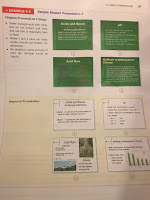Engineering Communication
Presentation skills are very important because engineers very often present their ideas to an audience. It is important to understand that the presenter is more important than the presentation. A presentation will not hold the audiences attention, the presenter will. Before making the presentation and presenting it is essential to Preplan and ask yourself these questions:
- Who is my audience?
- What is my Purpose?
- Where is all the equipment I need?
- When am I on the program agenda?
- Why am I giving this talk?
- How long should I talk?
It is always important to note the 5 W's and 1 H listed above. Also it is vital to make sure you look at the following:
- Shortness
- Simplicity
- Strength
- Sincerity
Introduction is the beginning of a speech and is essential to grabbing the attention of your audience.
Body is what makes up the majority of a speech and is important to keep your audience interested in the information being given. Conclusion is the end of a paper and is important to put it all together. In other words to summarize, showing appreciation, and allowing questions.
A well designed presentation is important because it need to be able to hold the audiences attention while at the same time being easy to understand.
In the book it shows the do's and do not's of some Sample Presentations.
There are some very important do's and don'ts to note:
DO:
- Relax.
- Speak slowly and clearly, making good eye contact.
- When your hands are not busy, drop them to your sides.
- Rehearse your presentation out loud multiple times. Get a friend to critique.
- Arrive early enough to make sure technology is working, and to resolve any problems.
DON'T:
- Lean on objects, turn your back to the audience, or cover your mouth.
- Read your presentation from the text.
- Tell inappropriate jokes.
- Stammer, overuse "I" or say "uh" or "um". silence is okay to recollect your thoughts.
- Chew gum, remove coins from pocket, crack knuckles.
- Shuffle feet or slouch, or sway, or pace.
- Play with notes.
The general guidelines of the Basic Technical Writing Skills goes as follows:
- Be clear, use precise language
- Ensure that finished copy logically and smoothly flows towards a conclusion. Check for Choppiness or discontinuity. avoid long sentences.
- If possible use 10 point font and 1.5 line spacing.
- Define any terms used that might be unfamiliar to the reader.
- Present facts or inferences rather than personal feelings.
- Maintain a professional tone
- Number and caption all titles, figures and appendices
- Proofread and edit several times - include headings, figures, tables, captions, and references.
- Read it twice - and edit accordingly.
- Spell out numbers that starts sentences.
- Keep the leading zero with a decimal.
- For long numbers do not spell out.
- Use dollar symbol.
- Watch for Sig Figs. Keep it reasonable.
When making your presentations or writing your reports make sure that you are Properly Using References. The following will help you avoid errors in the communication:
- Authority - Is it clear who is responsible for the work?
- Bias - Is the article free of any bias?
- Currency - When was the information updated?
- Use sources reviewed by experts.
- Secure a peer review.
- Compare the info found in your article or website with other content from other articles and/or websites.
- Corroborate the information.
Emailing is a vital part of professional technical communication. When you finish writing the email in question you have to ask yourself if you would mind the president of your university, CEO of your company, or even your parents to read the email, if not you should reword the email. Things to check while creating your email include:
- Use the correct address for the recipient.
- Use an appropriate subject line.
- Sign your full name and include contact information. Include your course day and time when referring about a class.
- Change your sending name to your full name.
- Keep it Brief.
- If you expect a response be sure your action items are clearly stated.
- Use correct capitalization and punctuation.
- Avoid putting something in an email that you would not say in person.
- To avoid accidently sending the email without looking it over fill the TO: and CC: lines last.
- When waiting for a response wait during a grace period of 48-72 hours. If you have not received a response, then you can resend the email inquiring politely if it was received.
All of the guidelines together make for an excellent and professional email.



*****
ReplyDelete